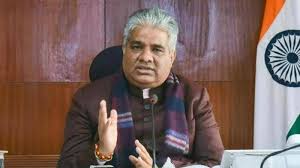Revised Green India Mission plan: Centre to focus on Aravalli, Western Ghats restoration

The central government has launched a revised version of the Green India Mission (GIM). This updated plan highlights the restoration of two ecologically important areas — the Aravalli hills and the Western Ghats. The mission aims to tackle climate change, improve carbon sinks, and revive degraded forests.
Shift in Priorities Under Green India Mission
The Green India Mission began in 2014 as part of India’s National Action Plan on Climate Change (NAPCC). Its original goal was to boost forest and tree cover across 10 million hectares. However, the initiative has faced several setbacks, including limited funding and slow progress.
The revised version brings a new focus. It targets climate-sensitive and ecologically vital areas like the Aravalli Range and Western Ghats, which play a key role in environmental stability and local livelihoods.
Why Focus on Aravallis and Western Ghats?
The Aravalli Range stretches across Gujarat, Rajasthan, Haryana, and Delhi. It’s one of the world’s oldest mountain systems. However, mining, deforestation, and urban expansion have severely damaged this landscape. The range is crucial for groundwater recharge and acts as a barrier against desertification.
The Western Ghats, a UNESCO World Heritage site, span five states: Maharashtra, Goa, Karnataka, Kerala, and Tamil Nadu. They are rich in biodiversity and support the monsoon cycle. But unchecked development, encroachments, and unsustainable farming threaten their ecosystem.
The revised GIM will increase native tree cover, prevent soil erosion, and restore water systems in these regions.
Stronger Role for Local Communities
The new strategy encourages community participation. The government plans to work closely with local self-governments, forest communities, and tribal groups. This ensures that conservation is not just a top-down effort but a collective one.
“The goal goes beyond planting trees. It’s about building climate-resilient landscapes and improving livelihoods for people who rely on forests,” said an environment ministry official.
This participatory model promotes ownership and accountability, which are vital for lasting success.
Increased Funding and State Cooperation
The Centre will increase funding for the revised mission. Earlier, annual allocations were around ₹100–200 crore. The government now plans to boost the budget significantly, though exact figures are awaited.
Since both the Aravallis and Western Ghats cover multiple states, coordination is key. The mission will involve joint forest management groups, watershed committees, and biodiversity boards to carry out location-specific plans.
Tech-Based Monitoring for Results
To ensure transparency, the mission will use remote sensing, GIS tools, and drone surveys. These technologies will help track forest growth, soil quality, and water levels.
The data will be collected on a central portal. This enables real-time monitoring and better policy decisions.
Global Commitments and Climate Goals
This revised plan aligns with India’s goals under the Paris Agreement. It also supports the Global Biodiversity Framework, which aims to restore 30% of degraded land by 2030.
Efforts in the Aravalli and Western Ghats will strengthen India’s carbon sink goals. They will also help reduce the effects of climate disasters like floods, droughts, and heatwaves.
Challenges to Restoration
Experts warn that success will depend on resolving land ownership issues, policy gaps, and commercial pressures. For instance, illegal mining continues in the Aravallis, despite court orders.
In the Western Ghats, real estate and hydropower projects pose a serious threat. Unless these are controlled, the mission’s efforts may fall short.
Looking Ahead
Environmental groups welcome the government’s renewed focus. However, they call for transparency, independent audits, and citizen oversight. India faces growing environmental risks. Programs like GIM can make a difference — but only with strong political will and public support.






